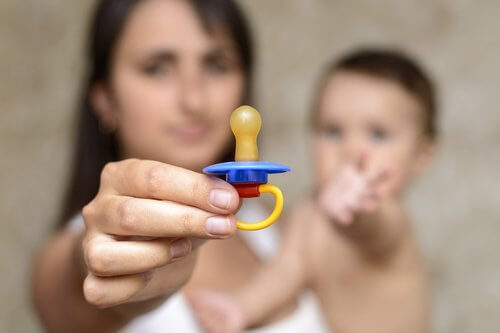Four Tips for Children to Stop Sucking Their Thumb

Parents worry when they see children sucking their thumb. It’s true that it can cause serious health problems, and not just for their teeth, and therefore it’s understandable why parents would be concerned about it. In view of this, parents seek different methods to prevent their children from sucking their thumbs.
Have you seen sonograms of babies in the womb sucking their thumb too? It’s a way they explore the world around them, and it’s completely normal. So before you get too worried, let’s first try to understand why they do it.
Thumb or pacifier?
Babies naturally have a sucking reflex. In fact, they need it to survive. It’s how they get food, and it calms them down. A baby who is nursing might not need to suck their thumb or use a pacifier, since they have their mother to feed them and calm them down.
However, it’s normal for a baby to start putting a finger or two in their mouths between the ages of two and six months. It’s one of their stages of development, a way they self-soothe.
A lot of parents think that giving them a pacifier is better than letting them suck their thumb.

Understandably, they say that it’s easier to take a pacifier away when the time comes. You can’t take their thumbs away!
However, the two have the same consequences if used after a child turns two years:
- Misalignment of the teeth and deformation of the mouth
- Pronunciation problems
- Hiding underlying emotional problems
How to stop a child from sucking their thumb
As normal as it is for a baby to put their fingers (and thumbs) into their mouth, it’s also normal for them to stop at around two years old. So under that age, there’s no reason to worry.
When they turn three or four, and they’re still sucking their thumb a lot, observe them and look for underlying reasons. That way you’ll be able to find more effective ways to get them to stop and thus protect their teeth.
However, since no two children are alike, and they develop at different paces, it can be said that the moment to start taking action is when their front teeth start appearing.
If you’ve noticed that the teeth are starting to grow apart in order to make room for the thumb, it’s definitely time. Here are 4 basic tips to help you out.
1. Determine the cause and give them other options
If your child sucks their thumb to help themselves fall asleep, give them other forms of support at bedtime. Tuck them in, tell them a story, give them their favorite stuffed animal or doll to distract them from sucking their thumb.

If they suck their thumb when they’re upset or anxious, maybe all you need to do is just talk to them, give them a hug, and comfort them.
Now, if your child does it when they’re bored, it’s time to spur on their creativity and distract them. Start a game, do a craft, take a walk… that could be exactly what they’re really asking for when they suck their thumb.
2. Explain the consequences of sucking their thumb
Sometimes you jump right to using tricks or seeing a doctor when you really could start with just sitting down and talking to them. Give them a simple explanation of why it’s not a good idea for them to keep sucking their thumb.
You might be surprised at how much children understand what you tell them, and how they’ll act accordingly. Tell them that their teeth could get messed up, that they’re not a baby anymore, and that now it’s time to stop sucking their thumb.
However, don’t make them feel embarrassed in front of other people. Definitely don’t yell at them or punish them if you catch them with their thumb in their mouth. They might stop doing it in front of you but keep it up when they’re alone. It’s much better to use positive reinforcement every time you see them handling the root cause (sleepiness, anxiety, boredom) in a better way.
Read all about The Habits You Should Instill in Your Children
3. Cover their thumb
You might find it necessary to take further steps to keep your child from sucking their thumb. They probably have some kind of callus on it from the sucking, so cover it with a band-aid and explain that it’s to make the callus better.

If they try to suck their thumb, the texture and taste of the band-aid will be a deterrent. Some parents also put vinegar or lemon on it to make it even more unpleasant. Do what works for you.
After the 2 weeks, if your child hasn’t sucked their thumb and if you’ve been working on the underlying causes, the behavioral change is probably complete.
4. Get an expert’s advice
If none of the tips above worked to get your child to stop sucking their thumb, it’s time to get the help of a specialist. An orthodontist can have a device made that will keep them from putting their thumb in their mouth, for example.
However, if the problem seems disproportionate or out of control, then you’ll need to seek advice from a child psychologist. It could be a sign of a deeper, more serious problem.
All cited sources were thoroughly reviewed by our team to ensure their quality, reliability, currency, and validity. The bibliography of this article was considered reliable and of academic or scientific accuracy.
- Ellingson, S. A., Miltenberger, R. G., Stricker, J. M., Garlinghouse, M. A., Roberts, J., Galensky, T. L., & Rapp, J. T. (2000). Analysis and treatment of finger sucking. J Appl Behav Anal. https://doi.org/10.1901/jaba.2000.33-41
- Stricker, J. M., Miltenberger, R. G., Anderson, C. F., Tulloch, H. E., & Deaver, C. M. (2002). A functional analysis of finger sucking in children. Behavior Modification. https://doi.org/10.1177/0145445502026003008
- Pădure, H., Negru, A. R., & Stanciu, D. (2012). The class II/1 anomaly of hereditary etiology vs. thumb-sucking etiology. Journal of Medicine and Life.
This text is provided for informational purposes only and does not replace consultation with a professional. If in doubt, consult your specialist.








